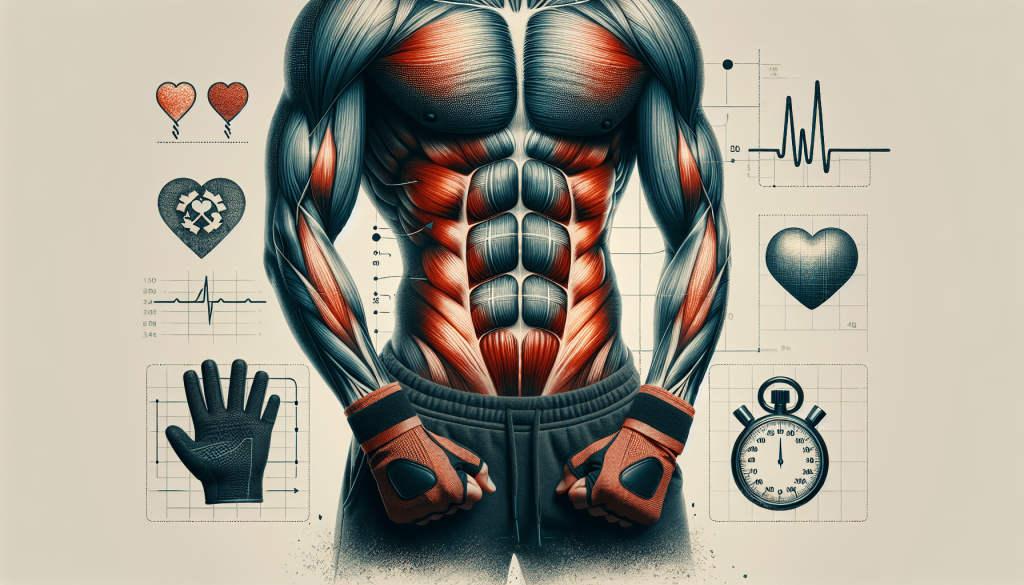Are you eager to build those coveted six-pack abs and strengthen your core muscles? It’s important to know the signs of overexertion when working on your abs to avoid potential injury and ensure you’re training effectively. In this article, we’ll address the common questions people have about building abs and discuss the telltale signs that indicate you may be pushing yourself too hard. So, let’s dive right in and learn how to strike the perfect balance in your ab workouts for optimal results and a healthy body.

Understanding Overexertion
Overexertion refers to pushing your body beyond its limits and capacity, resulting in physical, mental, and emotional strain. It occurs when you subject your muscles, joints, and cardiovascular system to excessive stress and fatigue. While pushing yourself during workouts is important for progress, it is crucial to recognize the signs of overexertion to prevent injuries and ensure long-term health and fitness. Understanding the definition, importance, and dangers of overexertion will enable you to make informed decisions and take necessary precautions.
Defining Overexertion
Overexertion is defined as the excessive use or strain of one’s body, usually during physical activity or exercise. It encompasses both acute overexertion, which occurs from a single intense workout session, and chronic overexertion, which accumulates over time due to repetitive stress and inadequate rest. It is important to differentiate overexertion from regular muscle soreness and fatigue, as overexertion involves pushing beyond healthy limits and often leads to negative consequences.
Importance of Recognizing Overexertion
Recognizing the signs of overexertion is crucial for maintaining a safe and effective fitness routine. Ignoring these signs can lead to serious injury and setbacks in your progress. By being mindful of your body’s signals, you can make informed decisions and adjust your workout intensity and duration accordingly. Understanding the importance of recognizing overexertion will empower you to prioritize your wellbeing and strike a balance between challenging yourself and avoiding harm.
Dangers of Overexertion
Overexertion poses various risks to your physical and mental health. It can lead to acute injuries such as sprains, strains, and muscle tears, as well as chronic conditions like tendinitis and stress fractures. Additionally, the strain on your cardiovascular system during overexertion can put excessive pressure on your heart, increasing the risk of heart-related issues. Mentally and emotionally, overexertion can contribute to burnout, fatigue, and a negative perception of exercise. Understanding the dangers of overexertion underscores the importance of taking preventive measures and listening to your body’s needs.

Physical Signs of Overexertion
Recognizing physical signs of overexertion is essential in identifying when you may be pushing yourself too hard. These signs include muscle soreness, muscle fatigue, persistent pain, decreased performance, and difficulty breathing.
Muscle soreness is a common indicator of overexertion. While mild muscle soreness is typical after a challenging workout, excessive soreness that lasts for several days or intensifies with movement suggests overexertion.
Muscle fatigue occurs when your muscles become exhausted and struggle to perform at their usual capacity. It can manifest as weakness, heaviness, or a loss of power during exercises.
Persistent pain that goes beyond normal muscle soreness should not be ignored. Sharp, localized, or radiating pain can indicate overexertion and require medical attention.
Decreased performance refers to a decline in your ability to perform exercises or activities at the same level as before. If you notice a significant drop in your strength, endurance, or flexibility, overexertion may be a contributing factor.
Difficulty breathing can occur during or after exercise and may be a sign of overexertion, particularly if it is accompanied by dizziness, lightheadedness, or chest discomfort. Paying attention to your breathing patterns during workouts is crucial.
Mental and Emotional Signs of Overexertion
In addition to physical manifestations, overexertion can have mental and emotional impacts. Recognizing these signs is important for maintaining overall wellbeing and avoiding burnout. Mental and emotional signs of overexertion include persistent fatigue, mood changes, lack of motivation, irritability, and difficulty concentrating.
Persistent fatigue that goes beyond normal tiredness after a workout can be an indication of overexertion. If you consistently feel exhausted and struggle to recover even after adequate rest, it may be time to reevaluate your exercise routine.
Mood changes can arise from overexertion due to hormonal imbalances and increased stress. You may experience mood swings, feelings of irritability, or even symptoms of depression or anxiety.
Lack of motivation can be a result of overexertion, as your body and mind may be worn out from excessive physical activity. If you find it challenging to stay motivated or feel a sense of dread towards exercise, overexertion could be playing a role.
Irritability often accompanies overexertion due to the physical and mental stress it places on your body. If you find yourself becoming easily annoyed or impatient, it may be a sign that you need to take a step back and prioritize rest.
Difficulty concentrating can arise when your body and mind are fatigued from overexertion. You may find it harder to focus, experience brain fog, or struggle with mental clarity during workouts.

Signs of Overexertion during Workouts
During your workouts, specific signs can indicate that you are overexerting yourself. Being aware of these signs will help you make necessary adjustments to prevent injuries and ensure a safe and effective training session.
Inability to complete exercises as you normally would may indicate overexertion. If you consistently find yourself unable to finish sets or perform movements with proper form, it is a red flag that you may be pushing your body too hard.
Excessive sweating beyond what is typical for your body during exercise can signify overexertion. This may be accompanied by an increased heart rate and feelings of fatigue and exhaustion.
Nausea or dizziness during or after workouts can be a sign that you have pushed yourself beyond your limits. It is crucial not to dismiss these symptoms, as they may indicate overexertion or potentially more severe issues.
Rapid heartbeat that persists even after resting indicates that you may have been working at an intensity that is too high for your fitness level. Your heart should be able to recover to a more normal rate relatively quickly after exercise.
Cramping or spasms in your muscles during or after workouts can be an indicator of overexertion. These involuntary contractions can occur due to fatigue, dehydration, or imbalances in electrolytes.
Warning Signs of Overexertion
Certain warning signs of overexertion should never be ignored, as they may indicate more severe consequences. If you experience any of these warning signs, it is essential to take immediate action and seek medical attention if necessary.
Extreme muscle soreness that is significantly more intense than usual can be a warning sign of overexertion. If the soreness persists for an extended period or inhibits your daily activities, it is important to consult a healthcare professional.
Severe muscle weakness that goes beyond normal muscle fatigue can point to overexertion. If you are unable to perform basic tasks or experience difficulty with simple movements, it is crucial to address this issue promptly.
Sharp or shooting pains during or after exercise should not be ignored. These pains may indicate an injury or overexertion that requires medical attention to prevent further damage.
Fainting or near-fainting during or after exercise is a severe warning sign of overexertion. It suggests that your body is under significant stress and may not be able to handle the intensity of your workouts.
Chest pain or tightness that occurs during exercise or at rest should never be ignored. These symptoms may indicate overexertion and could potentially be signs of a more serious underlying condition. Seeking medical evaluation is crucial to ensure your heart health.

Preventing Overexertion
Preventing overexertion is key to maintaining a safe and sustainable fitness routine. By implementing the following strategies, you can reduce the risk of overexertion and prioritize your long-term health and well-being.
Building a foundation for fitness is essential to prevent overexertion. Start with a program that is appropriate for your current fitness level and gradually progress from there. Establish a solid base before taking on more advanced workouts.
Gradually increasing intensity of your workouts is crucial to avoid sudden spikes in exertion that may lead to overexertion. Incrementally challenging yourself allows your body to adapt and adjust without undue stress.
Listening to your body is perhaps the most important aspect of preventing overexertion. Pay attention to how your body feels during and after workouts. If something doesn’t feel right or you experience unusual levels of fatigue or discomfort, it is essential to scale back and rest.
Proper rest and recovery play a significant role in preventing overexertion. Allow your body time to adapt and repair by incorporating rest days into your routine. Prioritize sleep, as it is when your body undergoes essential recovery processes.
Maintaining a balanced workout routine is key to preventing overexertion. Incorporate a variety of exercises that target different muscle groups and include different modalities such as strength training, cardio, and flexibility work. Avoid over-focusing on one area or type of exercise.
Reacting to Overexertion
Reacting appropriately to signs of overexertion is crucial for your well-being and preventing further complications. By following these steps, you can address overexertion promptly and avoid prolonged negative effects.
Recognize the signs of overexertion by paying attention to your body’s cues and comparing them to the outlined physical, mental, and emotional signs mentioned earlier. Awareness is the first step toward addressing overexertion.
Stop the activity that is causing or exacerbating your overexertion. Continuing to push through when you are already overexerted can worsen the situation and increase the risk of injury or other health issues.
Rest and recover by taking a break from intense exercise and allowing your body time to heal. Incorporate active recovery methods such as light stretching, walking, or gentle yoga to promote blood flow and aid in the recovery process.
Seek medical attention if your symptoms persist or worsen. A healthcare professional can evaluate your condition and provide appropriate guidance or treatment if needed. It is essential not to downplay or ignore the signs of overexertion that may require medical intervention.
Re-evaluate your workout plan to identify potential causes of overexertion and make necessary modifications. This may involve adjusting the intensity, duration, or frequency of your workouts or seeking guidance from a fitness professional.

Common Mistakes Leading to Overexertion
Avoiding common mistakes during your fitness journey can significantly reduce the risk of overexertion. By being mindful of these pitfalls, you can maintain a safe and balanced exercise routine.
Pushing too hard, too soon is a common mistake that often leads to overexertion. It is important to gradually increase the intensity of your workouts and allow your body time to adapt and build strength.
Neglecting rest days is a mistake that can prevent proper recovery and increase the risk of overexertion. Rest days allow your muscles and joints to recover, reducing the likelihood of injury and burnout.
Ignoring pain or discomfort is a dangerous mistake that can aggravate overexertion and potentially cause more severe injuries. It is essential to listen to your body and address any pain or discomfort promptly.
Neglecting proper form during exercises can result in overexertion, as compensatory movements may place excessive strain on certain muscles or joints. Focus on maintaining correct form and seek professional guidance if needed.
Lack of variety in workouts can lead to overexertion and imbalances in your body. Incorporating different types of exercises, such as strength training, cardio, and flexibility work, ensures a well-rounded routine and reduces the risk of overexertion.
Workout Modifications for Overexertion
If you find yourself facing overexertion, there are several modifications you can make to your workouts to allow for recovery and prevent further strain.
Decreasing intensity is crucial when you are in a state of overexertion. Dial back the resistance, weight, or speed in your exercises to a level that feels more manageable for your current condition.
Reducing workout duration allows your body additional time to recover. Shorten the duration of your workouts or allocate more time to rest and recovery activities.
Incorporating active recovery exercises, such as light stretching, low-impact cardio, or yoga, can help promote blood flow, reduce muscle soreness, and aid in quicker recovery.
Focusing on stretching and flexibility exercises can be beneficial if overexertion has caused muscle tightness or reduced mobility. Spend dedicated time on improving flexibility and range of motion to aid in recovery and prevent future injuries.
Seeking professional guidance from a qualified personal trainer or exercise specialist can provide valuable insights and modifications tailored to your specific situation. They can help you design a safe and effective workout plan that avoids overexertion.
Conclusion
Understanding and addressing overexertion are essential for your overall health and well-being. By recognizing the signs of overexertion, taking preventive measures, and adjusting your workouts accordingly, you can prioritize injury prevention and foster a balanced approach to fitness. Remember to listen to your body, seek professional guidance when needed, and prioritize rest and recovery. By doing so, you can maintain a sustainable exercise routine that supports your long-term health and goals.





